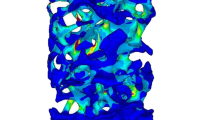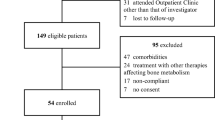Abstract
Summary
We aimed to determine the effects of bisphosphonates on mechanical properties independent of changes in bone density. Our results show that at equivalent bone densities, vertebrae from beagles treated with bisphosphonate have equivalent bone strength and reduced bone energy absorption compared to those from untreated animals.
Introduction
Assessing the relationship between mechanical properties and bone density allows a biomechanical evaluation of bone quality, with differences at a given density indicative of altered quality. The purpose of this study was to evaluate the strength-density and energy absorption-density relationships in vertebral bone following a one-year treatment with clinical doses of two different bisphosphonates in beagle dogs.
Methods
Areal bone mineral density (aBMD) and compressive mechanical properties (ultimate load and energy absorption) were assessed on lumbar vertebrae from skeletally mature beagle dogs treated with vehicle (VEH), alendronate (ALN), or risedronate (RIS). Relationships among properties were assessed using analyses of covariance.
Results
Neither treatment altered the strength-density relationship compared to VEH, suggesting increases in vertebral strength with bisphosphonate-treatment are explained by increased density. The energy absorption-density relationship was altered by ALN, resulting in significantly lower energy absorption capacity at a given aBMD compared to both VEH (−22%) and RIS (−14%).
Conclusions
These data document that after adjusting for increased aBMD, vertebrae from animals treated with bisphosphonates have similar strength as those from untreated animals. Conversely, when adjusted for increased aBMD, alendronate treatment, but not risedronate treatment, significantly reduces the energy required for vertebral fracture, indicative of an alteration in bone quality.

Similar content being viewed by others
References
Delmas PD, Li Z, Cooper C (2004) Relationship between changes in bone mineral density and fracture risk reduction with antiresorptive drugs: some issues with meta-analyses. J Bone Miner Res 19:330–337
Delmas PD, Seeman E (2004) Changes in bone mineral density explain little of the reduction in vertebral or nonvertebral fracture risk with anti-resorptive therapy. Bone 34:599–604
Black DM, Cummings SR, Karpf DB, Cauley JA, Thompson DE, Nevitt MC, Bauer DC, Genant HK, Haskell WL, Marcus R, Ott SM, Torner JC, Quandt SA, Reiss TF, Ensrud KE (1996) Randomized trial of effect of alendronate on risk of fracture in women with existing vertebral fractures. Fracture Intervention Trial Research Group. Lancet 348:1535–1541
Ettinger B, Black DM, Mitlak BH, Knickerbocker RK, Nickelsen T, Genant HK, Christiansen C, Delmas PD, Zanchetta JR, Stakkestad J, Gluer CC, Krueger K, Cohen FJ, Eckert S, Ensrud KE, Avioli LV, Lips P, Cummings SR (1999) Reduction of vertebral fracture risk in postmenopausal women with osteoporosis treated with raloxifene: results from a 3-year randomized clinical trial. Multiple Outcomes of Raloxifene Evaluation (MORE) Investigators. JAMA 282:637–645
Harris ST, Watts NB, Genant HK, McKeever CD, Hangartner T, Keller M, Chesnut CH 3rd, Brown J, Eriksen EF, Hoseyni MS, Axelrod DW, Miller PD (1999) Effects of risedronate treatment on vertebral and nonvertebral fractures in women with postmenopausal osteoporosis: a randomized controlled trial. Vertebral Efficacy With Risedronate Therapy (VERT) Study Group. JAMA 282:1344–1352
Hernandez C, Keaveny T (2006) A biomechanical perspective on bone quality. Bone 39:1173–1181
Turner CH, Burr DB (1993) Basic biomechanical measurements of bone: a tutorial. Bone 14:595–608
Allen MR, Iwata K, Phipps R, Burr DB (2006) Alterations in canine vertebral bone turnover, microdamage accumulation, and biomechanical properties following 1-year treatment with clinical treatment doses of risedronate or alendronate. Bone 39:872–879
Allen MR, Iwata K, Sato M, Burr DB (2006) Raloxifene enhances vertebral mechanical properties independent of bone density. Bone 39:1130–1135
Mashiba T, Turner CH, Hirano T, Forwood MR, Johnston CC, Burr DB (2001) Effects of suppressed bone turnover by bisphosphonates on microdamage accumulation and biomechanical properties in clinically relevant skeletal sites in beagles. Bone 28:524–531
Currey JD (2001) Bone strength: what are we trying to measure? Calcif Tissue Int 68:205–210
Currey JD (2004) Tensile yield in compact bone is determined by strain, post-yield behaviour by mineral content. J Biomech 37:549–556
Currey JD, Brear K, Zioupos P (1996) The effects of ageing and changes in mineral content in degrading the toughness of human femora. J Biomech 29:257–260
Burr D (2002) The contribution of the organic matrix to bone's material properties. Bone 31:8–11
Boivin GY, Chavassieux PM, Santora AC, Yates J, Meunier PJ (2000) Alendronate increases bone strength by increasing the mean degree of mineralization of bone tissue in osteoporotic women. Bone 27:687–694
Roschger P, Rinnerthaler S, Yates J, Rodan GA, Fratzl P, Klaushofer K (2001) Alendronate increases degree and uniformity of mineralization in cancellous bone and decreases the porosity in cortical bone of osteoporotic women. Bone 29:185–191
Zoehrer R, Roschger P, Paschalis EP, Hofstaetter JG, Durchschlag E, Fratzl P, Phipps R, Klaushofer K (2006) Effects of 3- and 5-year treatment with risedronate on bone mineralization density distribution in triple biopsies of the iliac crest in postmenopausal women. J Bone Miner Res 21:1106–1112
Gineyts E, Allen MR, Burr DB, Delmas PD (2006) Effects of Antiresorptive Therapy on the Bone Tissue Concentration of Enzymatic Mature Collagen Crosslinks and Pentosidine. J Bone Miner Res 21(Supp 1):M344
Vashishth D, Wu P, Gibson G (2004) Age-related loss in bone toughness is explained by non-enzymatic glycation of collagen. Trans Orthop Res Soc 29
Hernandez CJ, Gupta A, Keaveny TM (2006) A biomechanical analysis of the effects of resorption cavities on cancellous bone strength. J Bone Miner Res 21:1248–1255
Wachter NJ, Augat P, Mentzel M, Sarkar MR, Krischak GD, Kinzl L, Claes LE (2001) Predictive value of bone mineral density and morphology determined by peripheral quantitative computed tomography for cancellous bone strength of the proximal femur. Bone 28:133–139
Rosen CJ, Hochberg MC, Bonnick SL, McClung M, Miller P, Broy S, Kagan R, Chen E, Petruschke RA, Thompson DE, de Papp AE (2005) Treatment with once-weekly alendronate 70 mg compared with once-weekly risedronate 35 mg in women with postmenopausal osteoporosis: a randomized double-blind study. J Bone Miner Res 20:141–151
Acknowledgements
The authors thank Dr. Tony Keaveny for insightful discussion regarding the topics addressed in this paper. This work was supported by NIH Grants AR047838 and AR007581 and a research grant from The Alliance for Better Bone Health (Procter & Gamble Pharmaceuticals and sanofi-aventis). Merck and Co. kindly provided the alendronate. This investigation utilized an animal facility constructed with support from Research Facilities Improvement Program Grant Number C06 RR10601-01 from the National Center for Research Resources, National Institutes of Health.
Disclosures
Dr. Allen has research contracts with Eli Lilly and The Alliance for Better Bone Health. Dr. Burr has research contracts from Eli Lilly, Amgen and The Alliance for Better Bone Health. Furthermore, he serves on the Advisory Board for Eli Lilly and Company, and he has received lecture fees from Eli Lilly, The Alliance for Better Bone Health, Amgen, and Roche.
Author information
Authors and Affiliations
Corresponding author
Rights and permissions
About this article
Cite this article
Allen, M.R., Burr, D.B. Changes in vertebral strength-density and energy absorption-density relationships following bisphosphonate treatment in beagle dogs. Osteoporos Int 19, 95–99 (2008). https://doi.org/10.1007/s00198-007-0451-8
Received:
Accepted:
Published:
Issue Date:
DOI: https://doi.org/10.1007/s00198-007-0451-8




